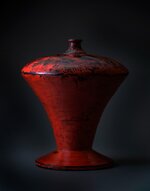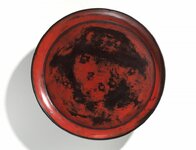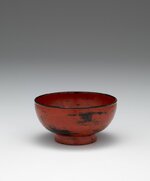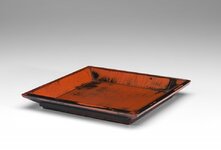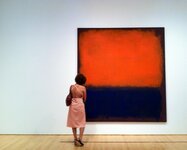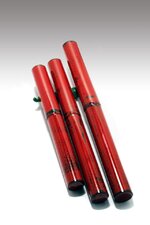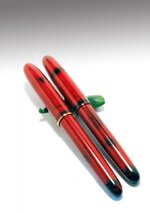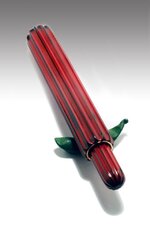manupropria
Member
THE REFINED BEAUTY AND RUSTIC AMBIENCE OF MEDIEVAL JAPAN
Most collectors and lovers of Japanese Pens are familiar with "Maki-e" (Maki = sprinkling, E = picture) but it is not well known, that among the trade of urushi Maki-e is only one particular technique in which pictures are created by using different metal powders that are sprinkled into wet lacquer and polished.
There ar other techniques that I will introduce and explain in posts to follow.
Today I would like to introduce to you a lacquer called Negoro.
Negoro refers to simple and elegant red lacquer objects that were produced during Japan's medieval period, between the twelfth and seventeenth centuries in a Buddhist temple with the name "Negoro-Ji". The Negoro-ji (根来寺) complex of Buddhist temples stands on the side of, and is surrounded by, the sacred peaks of the Katsuragi Mountains, which dominate the horizon at the northern end of the city of Iwade, Wakayama in Japan. In 1585, buildings (except the main pagoda and a few others) were burnt down during the Siege of Negoro-ji by Toyotomi Hideyoshi. He feared the growing military power of the priesthood and the Negoro-gumi (warrior monks of the temple) who were skilled in the use of firearms. At Negoro-ji religious and every day products have all been lacquer with black urushi "kuro-nuri" and a final coat of red urushi "shû-neri". Over decades and centuries of use the red lacquer was worn down partially to release the black under coat.
Yô no Bi
Yô no bi' is an expression from the Japanese folk craft tradition and means 'beauty through use'. It is perfectly represented by Negoro lacquer.
Embodying the ancient sense of Japanese beauty, the minimalistic forms of Negoro lacquer ware were primarily made to be functional objects and are void of elaborate decoration. The supple shapes and naturally worn patina of red and black lacquered layers give Negoro an ambience of antiquity and elegance which has made them treasured objects throughout the ages. Since the early twentieth century Negoro wares have become highly appreciated by connoisseurs as objects of outstanding design that pursue a certain utilitarian beauty. Since ancient times the Neolithic people of Japan have used the sap of the lacquer tree (Japanese sumac, or Toxicodendron vernicifluum) mixed with cinnabar pigment to produce red lacquered objects for daily use. Red is considered a sacred and auspicious colour in Japan.
It is used widely as the colour of shrines and temples, as well as of sacred offering vessels and in some instances, such as red sea brim, the colour of the ritual offering itself. The first illustrated evidence of the use of red lacquer ware is found in handscrolls, including the twelfth-century Tale of Genji 'Kashiwagi' scroll in which circular trays similar to the one in the NGV collection are shown being used by members of the imperial aristocracy. In the fourteenthcentury handscroll Miraculous stories of the gods of Kasuga (Kasuga Gongen Genki-e), we see shrine priests eating from stem tables identical in appearance and age to examples in the NGV collection, and in the sixteenth-century The illustrated scroll of the sake and rice debate (Shuhanron ekotoba), we see monks using red lacquered trays, bowls and large dishes. In these depictions of monastery life and aristocratic villas Negoro utensils are clearly shown as favoured and cherished objects, alluding to demand for their production in large numbers.
Square and circular trays, bowls of various sizes and large spouted ewers were used at daily meals. Lobed cup stands, offering trays and sake bottles with foliate lids featured in temple rituals and clearly display lotus flower–inspired motifs common to Buddhist art. Stem tables were frequently used as offering stands and placed in altars of Buddhist temples and Shinto shrines.
Themes connected to Negoro Lacquer Wabi
What can we say, beyond mentioning that although these lacquer pieces usually are red, and show traces of the underlaying black, sometimes they are black and show traces of red. One can go further, and say that lovers of Negoro share a "wabi" aesthetic. That is, lovers of Negoro find beauty not in the display of cunning craftsmanship, and not in the ostentatious, but in the simple, the austere, the unadorned - or to be more exact, they find beauty where traces of black appear beneath the worn red surface, an adornment that is "natural" the product of time. In short, "wabi" is an aesthetic of poverty, an aesthetic that values the simple, the worn, the mellow. It is an aesthetic that finds beauty not only in the smooth face of a beauty queen, but in the wrinkled face of her grandmother.. Anyone who preferes worn jeans to brand-new jeans knows the beauty of "wabi".
Mottainai
Mottainai, [mottainai]) is a Japanese term conveying a sense of regret concerning waste. The expression "Mottainai!" can be uttered alone as an exclamation when something useful, such as food or time, is wasted, meaning roughly "what a waste!" or "Don't waste. In addition to its primary sense of "wastefulness", the word is also used to mean "impious; irreverent" or "more than one deserves". Mottainai is an old Buddhist word, which has ties "with the Shinto idea that objects have souls. Mottainai has been referred to as a tradition, a cultural practice, and an idea which is still present in Japanese culture, which has become an international concept.. Mottainai in Japanese refers to more than just physical waste (resources). It is even used to refer to thought patterns that give rise to wasteful action. Grammatically, it can be used in Japanese as an exclamation ("mottainai!") or as an adjective phrase ("it feels mottainai"). There is no plural form. The collection of mottainai things could be called mottainai koto.
As an exclamation ("mottainai!") it means roughly "what a waste!" or "Don't waste. An English equivalent is the saying "waste not, want not." A more elaborate meaning conveys a sense of value and worthiness and may be translated as "do not destroy (or lay waste to) that which is worthy. However, mottainai is an example of a word, like sukiyaki and sushi, that cannot easily or accurately be translated directly into other languages.
Mark Rothko
Negoro lacquer is often compared by art collectors and art specialists to the paintings of Mark Rothko. Mark Rothko born Markus Yakovlevich Rothkowitz (September 25, 1903 – February 25, 1970), was an American painter of Russian descent. Although Rothko himself refused to adhere to any art movement, he is generally identified as an abstract expressionist. With Jackson Pollock and Willem de Kooning, he is one of the most famous postwar American artists.
Kurosawa Akira
The Film director Kurosawa Akira was also a known collector of Negoro and he frequently exhibited masterpieces such as ritual sake bottles "heishi" circular trays "bon" and trays with ancled corners "ô-shiki". In the film "Thrones of Blood" a large number of Negoro were featured in a banquet scene. At Kurosawa's home Negoro trays and plates were often used when people from the film industry gathered there.
Museum of Modern Art
Kazumi Murose, urushi artist and a Living National Treasure was contracted to produce a Negoro lacquer door for the MOA Museum of Modern Art.
Symbolic of the Colors Red & Black
Red: Activity, dynamism, vitality, energy, determination love, strength, temperament, passion fire, danger, warning, blood, rage, blood, happyness, wealth
Black: Power, sexuality, sophistication, formality, elegance, wealth, mystery, fear, evil, unhappiness
Here some ebonite pens with negoro lacquer manufactured by Manu Propria Pens in Switzerland
Best regards,
Martin
Most collectors and lovers of Japanese Pens are familiar with "Maki-e" (Maki = sprinkling, E = picture) but it is not well known, that among the trade of urushi Maki-e is only one particular technique in which pictures are created by using different metal powders that are sprinkled into wet lacquer and polished.
There ar other techniques that I will introduce and explain in posts to follow.
Today I would like to introduce to you a lacquer called Negoro.
Negoro refers to simple and elegant red lacquer objects that were produced during Japan's medieval period, between the twelfth and seventeenth centuries in a Buddhist temple with the name "Negoro-Ji". The Negoro-ji (根来寺) complex of Buddhist temples stands on the side of, and is surrounded by, the sacred peaks of the Katsuragi Mountains, which dominate the horizon at the northern end of the city of Iwade, Wakayama in Japan. In 1585, buildings (except the main pagoda and a few others) were burnt down during the Siege of Negoro-ji by Toyotomi Hideyoshi. He feared the growing military power of the priesthood and the Negoro-gumi (warrior monks of the temple) who were skilled in the use of firearms. At Negoro-ji religious and every day products have all been lacquer with black urushi "kuro-nuri" and a final coat of red urushi "shû-neri". Over decades and centuries of use the red lacquer was worn down partially to release the black under coat.
Yô no Bi
Yô no bi' is an expression from the Japanese folk craft tradition and means 'beauty through use'. It is perfectly represented by Negoro lacquer.
Embodying the ancient sense of Japanese beauty, the minimalistic forms of Negoro lacquer ware were primarily made to be functional objects and are void of elaborate decoration. The supple shapes and naturally worn patina of red and black lacquered layers give Negoro an ambience of antiquity and elegance which has made them treasured objects throughout the ages. Since the early twentieth century Negoro wares have become highly appreciated by connoisseurs as objects of outstanding design that pursue a certain utilitarian beauty. Since ancient times the Neolithic people of Japan have used the sap of the lacquer tree (Japanese sumac, or Toxicodendron vernicifluum) mixed with cinnabar pigment to produce red lacquered objects for daily use. Red is considered a sacred and auspicious colour in Japan.
It is used widely as the colour of shrines and temples, as well as of sacred offering vessels and in some instances, such as red sea brim, the colour of the ritual offering itself. The first illustrated evidence of the use of red lacquer ware is found in handscrolls, including the twelfth-century Tale of Genji 'Kashiwagi' scroll in which circular trays similar to the one in the NGV collection are shown being used by members of the imperial aristocracy. In the fourteenthcentury handscroll Miraculous stories of the gods of Kasuga (Kasuga Gongen Genki-e), we see shrine priests eating from stem tables identical in appearance and age to examples in the NGV collection, and in the sixteenth-century The illustrated scroll of the sake and rice debate (Shuhanron ekotoba), we see monks using red lacquered trays, bowls and large dishes. In these depictions of monastery life and aristocratic villas Negoro utensils are clearly shown as favoured and cherished objects, alluding to demand for their production in large numbers.
Square and circular trays, bowls of various sizes and large spouted ewers were used at daily meals. Lobed cup stands, offering trays and sake bottles with foliate lids featured in temple rituals and clearly display lotus flower–inspired motifs common to Buddhist art. Stem tables were frequently used as offering stands and placed in altars of Buddhist temples and Shinto shrines.
Themes connected to Negoro Lacquer Wabi
What can we say, beyond mentioning that although these lacquer pieces usually are red, and show traces of the underlaying black, sometimes they are black and show traces of red. One can go further, and say that lovers of Negoro share a "wabi" aesthetic. That is, lovers of Negoro find beauty not in the display of cunning craftsmanship, and not in the ostentatious, but in the simple, the austere, the unadorned - or to be more exact, they find beauty where traces of black appear beneath the worn red surface, an adornment that is "natural" the product of time. In short, "wabi" is an aesthetic of poverty, an aesthetic that values the simple, the worn, the mellow. It is an aesthetic that finds beauty not only in the smooth face of a beauty queen, but in the wrinkled face of her grandmother.. Anyone who preferes worn jeans to brand-new jeans knows the beauty of "wabi".
Mottainai
Mottainai, [mottainai]) is a Japanese term conveying a sense of regret concerning waste. The expression "Mottainai!" can be uttered alone as an exclamation when something useful, such as food or time, is wasted, meaning roughly "what a waste!" or "Don't waste. In addition to its primary sense of "wastefulness", the word is also used to mean "impious; irreverent" or "more than one deserves". Mottainai is an old Buddhist word, which has ties "with the Shinto idea that objects have souls. Mottainai has been referred to as a tradition, a cultural practice, and an idea which is still present in Japanese culture, which has become an international concept.. Mottainai in Japanese refers to more than just physical waste (resources). It is even used to refer to thought patterns that give rise to wasteful action. Grammatically, it can be used in Japanese as an exclamation ("mottainai!") or as an adjective phrase ("it feels mottainai"). There is no plural form. The collection of mottainai things could be called mottainai koto.
As an exclamation ("mottainai!") it means roughly "what a waste!" or "Don't waste. An English equivalent is the saying "waste not, want not." A more elaborate meaning conveys a sense of value and worthiness and may be translated as "do not destroy (or lay waste to) that which is worthy. However, mottainai is an example of a word, like sukiyaki and sushi, that cannot easily or accurately be translated directly into other languages.
Mark Rothko
Negoro lacquer is often compared by art collectors and art specialists to the paintings of Mark Rothko. Mark Rothko born Markus Yakovlevich Rothkowitz (September 25, 1903 – February 25, 1970), was an American painter of Russian descent. Although Rothko himself refused to adhere to any art movement, he is generally identified as an abstract expressionist. With Jackson Pollock and Willem de Kooning, he is one of the most famous postwar American artists.
Kurosawa Akira
The Film director Kurosawa Akira was also a known collector of Negoro and he frequently exhibited masterpieces such as ritual sake bottles "heishi" circular trays "bon" and trays with ancled corners "ô-shiki". In the film "Thrones of Blood" a large number of Negoro were featured in a banquet scene. At Kurosawa's home Negoro trays and plates were often used when people from the film industry gathered there.
Museum of Modern Art
Kazumi Murose, urushi artist and a Living National Treasure was contracted to produce a Negoro lacquer door for the MOA Museum of Modern Art.
Symbolic of the Colors Red & Black
Red: Activity, dynamism, vitality, energy, determination love, strength, temperament, passion fire, danger, warning, blood, rage, blood, happyness, wealth
Black: Power, sexuality, sophistication, formality, elegance, wealth, mystery, fear, evil, unhappiness
Here some ebonite pens with negoro lacquer manufactured by Manu Propria Pens in Switzerland
Best regards,
Martin

